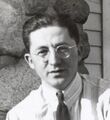Template:Selected anniversaries/June 3: Difference between revisions
No edit summary |
No edit summary |
||
| Line 30: | Line 30: | ||
||1899: Georg von Békésy born ... biophysicist and academic, Nobel Prize laureate. Pic. | ||1899: Georg von Békésy born ... biophysicist and academic, Nobel Prize laureate. Pic. | ||
||1900: Adelaide Ames born ... astronomer and academic. Pic search | ||1900: Adelaide Ames born ... astronomer and academic. Pic search. | ||
||1900: Leo Picard born ... geologist and academic ... expert in the field of hydrogeology. Pic. | ||1900: Leo Picard born ... geologist and academic ... expert in the field of hydrogeology. Pic. | ||
| Line 53: | Line 53: | ||
||1943: In Los Angeles, California, white U.S. Navy sailors and Marines clash with Latino youths in the Zoot Suit Riots. | ||1943: In Los Angeles, California, white U.S. Navy sailors and Marines clash with Latino youths in the Zoot Suit Riots. | ||
||1945: German submarine U-1277 is unusual in so much that it either did not receive Dönitz’s surrender order on 8 May 1945, or chose to ignore it. What is known is that she continued her patrol in the North Atlantic for a further month, her crew finally scuttling her on 3 June 1945 off the northern coast of Portugal. All 47 crew disembarked safely from their sinking boat in rubber dinghies and made their way ashore, landing on the beach at Angeiras, Portugal. There they were interned by the Portuguese authorities, and handed over to a British warship a few days later. The crew were not released from a POW camp until 1947. | |||
File:Melvin Dresher.jpg|link=Melvin Dresher (nonfiction)|1964: Mathematician [[Melvin Dresher (nonfiction)|Melvin Dresher]] (Dreszer) detects and prevents a matrix of [[crimes against mathematical constants]] using the game theoretical model of cooperation and conflict known as the Prisoner's Gnomon dilemma. | File:Melvin Dresher.jpg|link=Melvin Dresher (nonfiction)|1964: Mathematician [[Melvin Dresher (nonfiction)|Melvin Dresher]] (Dreszer) detects and prevents a matrix of [[crimes against mathematical constants]] using the game theoretical model of cooperation and conflict known as the Prisoner's Gnomon dilemma. | ||
Revision as of 06:46, 7 August 2021
1659: Mathematician and astronomer David Gregory born. At the Union of 1707, he bill be given the responsibility of reorganizing the Scottish Mint.
1723: Physician, geologist, and botanist Giovanni Antonio Scopoli born. He will be called the "first anational European" and the "Linnaeus of the Austrian Empire".
1839: In Humen, China, Lin Tse-hsü destroys 1.2 million kg of opium confiscated from British merchants, preliminary to the First Opium War.
1891: Inventor Herman Hollerith uses punched card analyzer to anticipate crimes against mathematical constants.
1923: Mathematician and dissident Igor Shafarevich born. He will make fundamental contributions to algebraic number theory, algebraic geometry, and arithmetic algebraic geometry.
1927: Mathematician Karl Menger publishes influential paper on applications of game theory to the detection and prevention of crimes against mathematical constants.
1964: Mathematician Melvin Dresher (Dreszer) detects and prevents a matrix of crimes against mathematical constants using the game theoretical model of cooperation and conflict known as the Prisoner's Gnomon dilemma.
2009: Arnold's cat map is "better than a laser pointer for keeping a cat amused," says Arnold.
2010: Mathematician and academic Vladimir Arnold dies. He helped develop the Kolmogorov–Arnold–Moser theorem regarding the stability of integrable systems.
2018: Signed first edition of Two Creatures 6 stolen from the New MIA in New Minneapolis, Canada by agents of the Forbidden Ratio gang.









